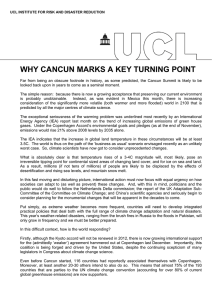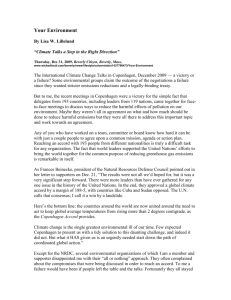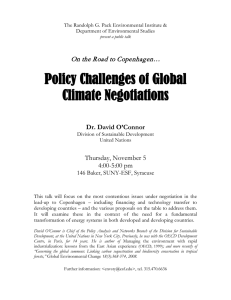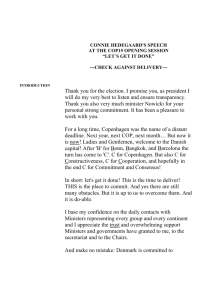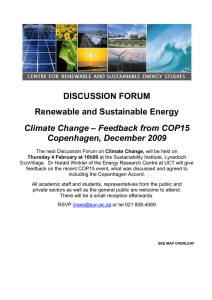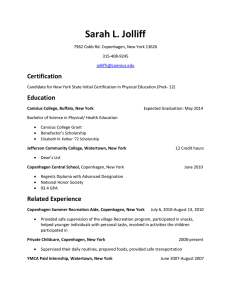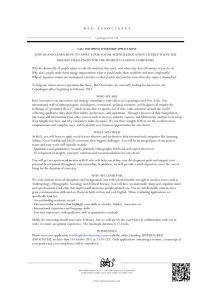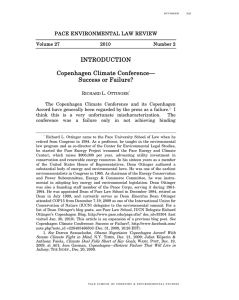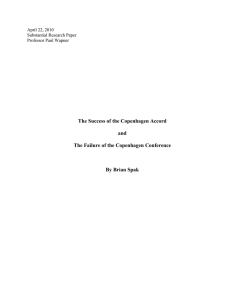W Report from Copenhagen Not Your Average Environmental Conference . . .
advertisement
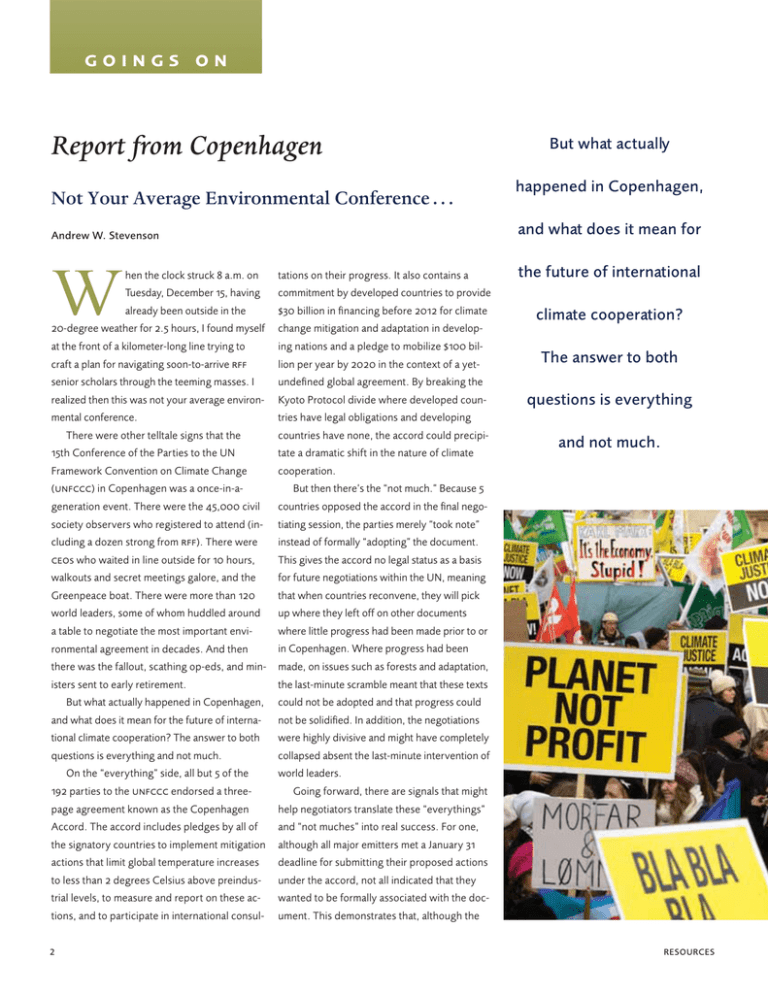
goings on Report from Copenhagen Not Your Average Environmental Conference . . . happened in Copenhagen, and what does it mean for Andrew W. Stevenson W But what actually hen the clock struck 8 a.m. on tations on their progress. It also contains a Tuesday, December 15, having already been outside in the commitment by developed countries to provide $30 billion in financing before 2012 for climate the future of international climate cooperation? 20-degree weather for 2.5 hours, I found myself at the front of a kilometer-long line trying to craft a plan for navigating soon-to-arrive rff senior scholars through the teeming masses. I change mitigation and adaptation in developing nations and a pledge to mobilize $100 billion per year by 2020 in the context of a yetundefined global agreement. By breaking the realized then this was not your average environmental conference. Kyoto Protocol divide where developed countries have legal obligations and developing questions is everything There were other telltale signs that the 15th Conference of the Parties to the UN countries have none, the accord could precipitate a dramatic shift in the nature of climate and not much. Framework Convention on Climate Change (unfccc) in Copenhagen was a once-in-ageneration event. There were the 45,000 civil society observers who registered to attend (including a dozen strong from rff). There were ceos who waited in line outside for 10 hours, walkouts and secret meetings galore, and the Greenpeace boat. There were more than 120 world leaders, some of whom huddled around a table to negotiate the most important environmental agreement in decades. And then there was the fallout, scathing op-eds, and ministers sent to early retirement. But what actually happened in Copenhagen, and what does it mean for the future of international climate cooperation? The answer to both questions is everything and not much. On the “everything” side, all but 5 of the 192 parties to the unfccc endorsed a threepage agreement known as the Copenhagen Accord. The accord includes pledges by all of the signatory countries to implement mitigation actions that limit global temperature increases to less than 2 degrees Celsius above preindustrial levels, to measure and report on these actions, and to participate in international consul- cooperation. But then there’s the “not much.” Because 5 countries opposed the accord in the final negotiating session, the parties merely “took note” instead of formally “adopting” the document. This gives the accord no legal status as a basis for future negotiations within the UN, meaning that when countries reconvene, they will pick up where they left off on other documents where little progress had been made prior to or in Copenhagen. Where progress had been made, on issues such as forests and adaptation, the last-minute scramble meant that these texts could not be adopted and that progress could not be solidified. In addition, the negotiations were highly divisive and might have completely collapsed absent the last-minute intervention of world leaders. Going forward, there are signals that might help negotiators translate these “everythings” and “not muches” into real success. For one, although all major emitters met a January 31 deadline for submitting their proposed actions under the accord, not all indicated that they wanted to be formally associated with the document. This demonstrates that, although the 2 The answer to both RESOURCES confrence represents a step forward as a high- India, Brazil, and South Africa—produced a three-page document called the Copenhagen Accord. The conference never formally level political understanding, the existing UN processes remain the only viable way to negotiate a new global agreement in the short to medium term. It is also clear that emerging Copenhagen’s Achievement: Not a Treaty but an Accord economies like China and India are willing to act, but they do not see a strong, top-down, multilateral climate regime as serving their national interests and will not agree to one in the foreseeable future. The United States will not make a binding J.W. Anderson international commitment unless these countries do as well. Over the next several years, na- B tions are likely to move toward a system where countries pledge actions and consult on their progress internationally, with no compliance penalties. This will place the focus squarely on binding international treaty on climate change, a cloud of disap- pointment and recrimination hangs over the memory of last December’s conference in Copenhagen. But that is the result of a peculiar political misunderstanding—a binding climate domestic actions and international financing for least-developed nations, especially for the United States and other major emitters. Although this may seem like a step back from Kyoto, by moving the focus from success in negotiations to success in climate action, it may turn out to be a major step forward after all. ∫ treaty never was remotely possible. A binding climate treaty is essentially a European concept, and the great example is the 1997 Kyoto Protocol. In the European view, associated press WINTER 2010 ecause it failed to produce a legally warmly embraced by many environmental organizations, the primary purpose of the Copenhagen meeting was to write a successor treaty to Kyoto, much of which expires in 2012. But Kyoto imposes limits only on countries that contribute less than one-third of the world’s emissions of carbon dioxide, the most prevalent of the greenhouse gases. By a more realistic measure, the first necessity at Copenhagen was to achieve a regime that would include all of the biggest sources of emissions—above all, China and the United States. Neither was limited by Kyoto, China because it was classified as a developing country and the United States because it refused to ratify the protocol. China had been making it clear for months that it would not accept emissions limits imposed by an international authority. As for the United States, anyone who had watched the struggles in the Senate to find 60 votes for reforms of health care or the financial system can judge the likelihood of getting 67 votes to ratify a climate treaty that, as a practical matter, would have been neither verifiable nor enforceable. Instead, five big countries—the United States with President Obama at the table, China, adopted it and only grudgingly deigned to take note of it. It asks all countries for voluntary pledges to cut emissions and sets up a registry to monitor the pledges. And the accord promises that the rich countries will give the poor ones $100 billion over the next decade to help them deal with changing climates. Given the accord’s nebulous legal status and the absence of any notable action since the conference, it’s fair to ask whether the agreement means much. One answer might be that, for the first time, the countries producing the greatest volumes of carbon dioxide now at least acknowledge a responsibility to do something about them. The accord also suggests a change in the negotiating process. The document was worked out in a meeting of five big countries and reflects a view among the Americans, and perhaps others, that the UN’s usual procedures, giving equal votes to all its members— 192 of which were represented at Copenhagen —and trying to operate by consensus, is too cumbersome and slow to be useful. But in response, there has been an outcry by small countries that see the UN and its conferences as the only venues in which they can hope to catch the world’s attention. The accord adopts a target of holding global temperature increases to 2 degrees Celsius. That’s quite a radical goal and would require a huge worldwide effort beginning in the very near future. The big countries now having at last engaged themselves in the governance of the world’s climate, the Copenhagen Accord now must address all the questions regarding how much more they are actually prepared to do. ∫ 3
